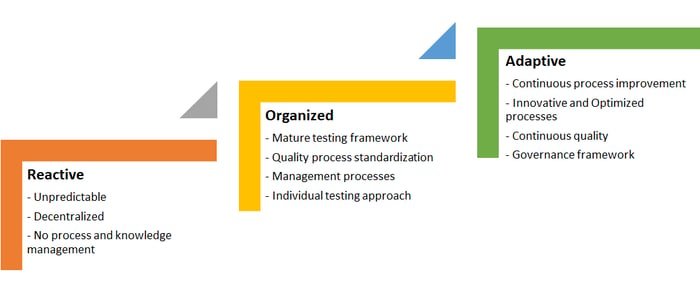Why are there so many defects in production even after spending time and cost on testing? How can I always see current proven progress and quality level? How can I speed up testing and release cycles with QA stream operations integrated with development? Which governance framework will make my QA practice more effective? Is it possible to set up a QA stream that works integrated with development?
Are you riddled with similar questions while ensuring software quality?
Well, your testing strategy a needs detailed test maturity assessment model with an improvement roadmap combining the Test Process Improvement (TPI®) methodology and the 360-degree QA Health Check framework. An enhanced version with the addition of some key focus areas which were not considered and improved with the change in technology, business, and execution methodology trends. The modernized approach is :
- an innovative method for test maturity in the QA process, specifically with an end-to-end solution and recommendations for test maturity improvement
- an intelligent and easier way to plugin with the existing process and help make informed decisions about improving testing performance.
A 360-degree health check reveals the health of a QA organization and recommends ways to set up a state-of-the-art, pragmatic QA organization tailored to business-specific needs. However, after several implementations and modifications with the existing customer, we developed a mature 360-degree model that ensures the testing processes operate to their full potential. We focus on the quality needs of the future, especially emerging technologies, and changing business needs & risks to build and adapt the QA practices in an organization. Following are some of the significant benefits of a business-driven approach to improve the testing process:
- Standardized test processes for all types of testing methodology
- Transparency in governance through metrics
- Reduced time spent on testing through automation and reusability
- A unified view of delivery performance and progress through
- Leverage testing specialists across engagements and continuous improvement
- Optimized tools and resources with cross-training and integrated tool strategy

We define a roadmap for the state-of-the-art test organization:
- Identify the details of the current situation
- Define the areas of improvement in QA practices
- Determine a detailed roadmap to create world-class QA practice
- Recommend a test organization set-up, practices, tools, technology, restructuring, KPIs, templates, end-to-end automated solution
- Leverage industry best practice accelerators and our Innovation Labs tools to reduce costs and improve productivity
The modern 360-degree model combined with our industry-standard TPI® methodology provides step-by-step guidance and recommendation roadmap to achieve the adaptive stage in test practices.




